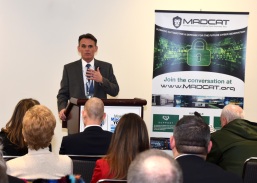Are you looking for your next career opportunity? If you answered yes and you work in the engineering, design, IT/cybersecurity, procurement and project management fields, you might just be in luck – as Macomb County recently announced a professional job fair for individuals working in these areas. The event will take place on Friday, April 12 from noon to 3 p.m. at the Sterling Banquet and Conference Center (34911 Van Dyke, Sterling Heights). It will feature more than 25 companies and organizations that are actively hiring, including BAE Systems, General Dynamics Land Systems, MB Aerospace, R&E Automated Systems and Waltonen Engineering. Interested individuals are asked to register for the free event at www.macombgov.org and those that do so on or before April 8 will receive early bird admittance at 11 a.m.

So – are you planning to attend? If you are, we found some tips on Monster.com that might help you land that new job:
Before the hiring event
- Develop a Strong Resume: Highlight your skills and accomplishments. Your resume should be error-free, concise and graphically pleasing. Don’t forget to make several copies, since you’ll probably visit with more than one employer.
- Get or Make Business Cards: You can buy blank business cards at stores like Office Depot, and then use a computer and laser printer to create some personalized cards. List your name, contact information, and perhaps the career you’d like to pursue or your key skills.
- Study the Organizations Attending the Fair: Nothing impresses an employer less than a prospective candidate asking, “So what do you guys do?” Instead, be one of the few attendees who know something about each of the companies. The more informed you are, the more likely you will be positively remembered.
- Develop a 30-Second Commercial: “Tell me a little about yourself.” You’re likely to get that invitation from many of the employers at the fair. So spend a little time beforehand figuring out your response. Think of your reply as a 30-second, self-promotional commercial you’ll deliver to each employer who asks.
During the hiring event
- Introduce Yourself and Shake Hands: In many ways, a career fair is a test of your social skills. While employers are almost always friendly and outgoing, they’ll expect the same of you. If you haven’t done much ice breaking before, practice in advance with a career counselor or friend.
- Dress Appropriately: In most cases, you’ll want to dress professionally to attend a career fair. Sometimes business casual is fine, but don’t go too casual. When in doubt, overdress.
- Ask Intelligent Questions: If you’ve studied up on the organizations, you’ll probably have some questions you’d like to ask. Not only will you get some answers, but you’ll also show yourself to be someone who does his research.
- Focus on What You Can Offer: You’ll be a refreshing change to most company representatives if you tell them what you can do for them and their organizations instead of asking what they can do for you.
- Leave Your Resume and Card with Each Representative: Then be sure to grab each representative’s card.
After the hiring event
- Take Notes: After the fair concludes, jot down notes about conversations you had with company representatives. If you wait too long, the conversations will start running together in your head, and you’ll forget what you said to whom.
- Follow Up on Promises: If, for example, a company representative expressed interest in looking at your Web site, make sure to email the URL like you said you would.
- Send Thank-You Notes: Write or email each of the people you met and thank them for their time. Reiterate your interest in the company and your relevant skills and experience. Most job seekers fail to take this simple step, often losing out in the end to those who did express their thanks.
If you have any questions about the upcoming hiring event in Macomb County, which is being hosted by Macomb County Planning and Economic Development, the Macomb County Chamber and Michigan Works!, contact Janice Loftis at jloftis@macomb-stclairworks.org or at 586-738-9034. Good luck!
**The above tips were pulled from an article on Monster.com here: https://www.monster.com/career-advice/article/learn-to-work-a-career-fair.
Megan Ochmanek is a communications specialist for the Macomb County Department of Planning and Economic Development.


 competitors. According to FIRST, this is as close to real-world engineering as a student can get.
competitors. According to FIRST, this is as close to real-world engineering as a student can get.

 With that goal in mind, the Association of the U.S. Army recently hosted an Autonomy and Artificial Intelligence Symposium and Exposition in Detroit. The two-day event saw hundreds of military leaders, defense industry representatives and robotics experts gather to showcase how the U.S. Army is developing critical capabilities in robotics, autonomy, machine learning and artificial intelligence. The ultimate goal – provide an open forum for attendees to discuss the Army’s efforts in creating autonomous systems while also providing a platform for industry partners to demonstrate technology breakthroughs that could help the military.
With that goal in mind, the Association of the U.S. Army recently hosted an Autonomy and Artificial Intelligence Symposium and Exposition in Detroit. The two-day event saw hundreds of military leaders, defense industry representatives and robotics experts gather to showcase how the U.S. Army is developing critical capabilities in robotics, autonomy, machine learning and artificial intelligence. The ultimate goal – provide an open forum for attendees to discuss the Army’s efforts in creating autonomous systems while also providing a platform for industry partners to demonstrate technology breakthroughs that could help the military.






 Gov. Rick Snyder, a longtime advocate for STEM education, addressed the group. Other notable presenters included Macomb County Executive Mark A. Hackel and Elaina Farnsworth. The robust professional lineup highlighted that the only viable option is taking an open, collaborative and inclusive approach to preparing for tomorrow today.
Gov. Rick Snyder, a longtime advocate for STEM education, addressed the group. Other notable presenters included Macomb County Executive Mark A. Hackel and Elaina Farnsworth. The robust professional lineup highlighted that the only viable option is taking an open, collaborative and inclusive approach to preparing for tomorrow today. The meeting on Thursday was part of an ongoing Cyber Pathways Project launched by MADCAT in 2017. Through a grassroots effort, leaders from the government, education, nonprofit and private sectors formed MADCAT in 2014 to address the growing threat of cybersecurity breaches to our region’s primary industries. MADCAT’s aim is to establish Macomb County as a cybersecurity center of excellence and to attract businesses and institutions that support the development, growth and retention of the talent pool.
The meeting on Thursday was part of an ongoing Cyber Pathways Project launched by MADCAT in 2017. Through a grassroots effort, leaders from the government, education, nonprofit and private sectors formed MADCAT in 2014 to address the growing threat of cybersecurity breaches to our region’s primary industries. MADCAT’s aim is to establish Macomb County as a cybersecurity center of excellence and to attract businesses and institutions that support the development, growth and retention of the talent pool.
 Macomb County Executive Mark A. Hackel, alongside the
Macomb County Executive Mark A. Hackel, alongside the  And the movement to bring home the F-35 is now picking up speed, thanks to several letters of support written by leaders from around the county.
And the movement to bring home the F-35 is now picking up speed, thanks to several letters of support written by leaders from around the county. Selfridge has a rich history, and it only makes sense that its history should be taken into account here. As noted by Kathleen Lomako, president of the Metropolitan Affairs Coalition, Selfridge was “one of the first military airfields in the nation.” During the Second World War, the base was “able to produce new bombers at the rate of one every hour, something no one thought possible at the time.” Our area has a proud tradition of being part of our nation’s air-based defense system, and, as Lomako writes, many believe that tradition “should be extended into the next century” with the housing of the F-35.
Selfridge has a rich history, and it only makes sense that its history should be taken into account here. As noted by Kathleen Lomako, president of the Metropolitan Affairs Coalition, Selfridge was “one of the first military airfields in the nation.” During the Second World War, the base was “able to produce new bombers at the rate of one every hour, something no one thought possible at the time.” Our area has a proud tradition of being part of our nation’s air-based defense system, and, as Lomako writes, many believe that tradition “should be extended into the next century” with the housing of the F-35. Lomako adds that there are plenty of non-military factors that make Selfridge an ideal location for the F-35 as well. Selfridge is “located in one of the largest metropolitan areas of the country,” which means its employees will have access to an efficient airport and to other employment opportunities after their military careers have ended. They will also be in close proximity to a “full spectrum of educational, commercial, and recreational services, which is desirable for any personnel stationed at the base.”
Lomako adds that there are plenty of non-military factors that make Selfridge an ideal location for the F-35 as well. Selfridge is “located in one of the largest metropolitan areas of the country,” which means its employees will have access to an efficient airport and to other employment opportunities after their military careers have ended. They will also be in close proximity to a “full spectrum of educational, commercial, and recreational services, which is desirable for any personnel stationed at the base.” The
The  Speaking of the F-35, two landed safely in France last week to debut at the Paris Air Show. Depending on the weather, the F-35 will fly during the trade show, and I will be sure to take videos to share with all of you on our
Speaking of the F-35, two landed safely in France last week to debut at the Paris Air Show. Depending on the weather, the F-35 will fly during the trade show, and I will be sure to take videos to share with all of you on our  Janelle Arbuckle is an economic development specialist for the Macomb County Department of Planning & Economic Development.
Janelle Arbuckle is an economic development specialist for the Macomb County Department of Planning & Economic Development.  With future prospects for security in mind,
With future prospects for security in mind,  Dan Rochon works for the Macomb County Department of Planning & Economic Development as an associate planner in economic development services.
Dan Rochon works for the Macomb County Department of Planning & Economic Development as an associate planner in economic development services.
